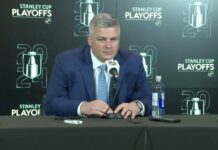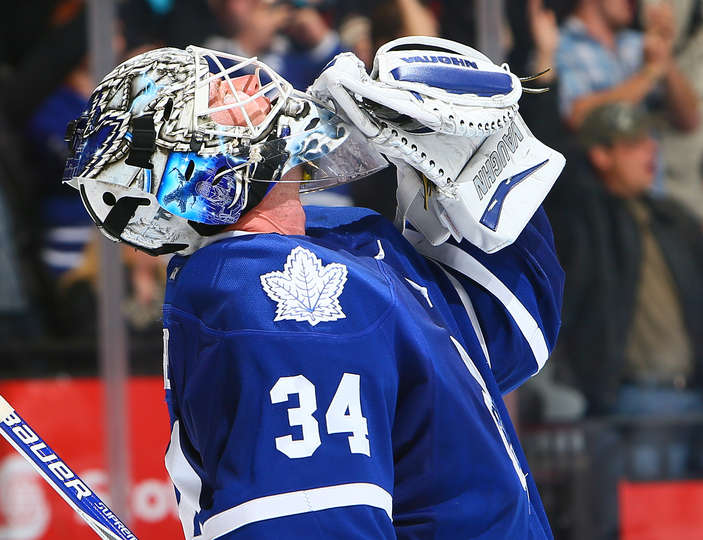A 3-0 week quieted the “blow it up” talk in Toronto,
but it will inevitably rear its ugly head again.
Rebuilding the team entirely would be the wrong call though.
Shedding some big contracts, however, may not be.
If we use the Pittsburgh Penguins as an example, tanking is a long and arduous process. Pittsburgh drafted Sidney Crosby first overall in 2005, which many people associate with the start of the rebuild. If drafting first overall is start of a rebuild, their rebuild really started in 2003 when they drafted Marc Andre Fleury with the top pick. They ended up winning the Cup in 2009, drafting perhaps two of the top 5 players in the league after drafting Fleury (Malkin and Crosby). They unofficially serve as the benchmark for how long it will take to build a system back up after bottoming out completely.
The Kings bottomed out in 2008, drafting Drew Doughty second overall that season, but they swung and hit on Anze Kopitar in 2005 to really kick start their build. Eventually, they won the Cup in 2012 and again last season. The 2010 and 2013 Champion Chicago Blackhawks got Jonathon Toews in 2006 followed by Patrick Kane in 2007, but they had been accumulating players since drafting Cam Barker third overall in 2003 (they got Bolland, Brouwer and Bickell out of that draft).
Building through the draft is discussed in terms of finding cornerstone pieces and depth, but quite literally what you’re trying to do in the draft is find the best players relative to their peers and consistently come out ahead. Using Chicago as an example, it’s true they drafted Kane and Toews in those aforementioned draft classes, but they also picked up Duncan Keith in 2002 and he has turned out to be the best defenseman in his class (closest defenseman to him is Jay Bouwmeester), Brent Seabrook (third in his draft class in games played, although not better than guys like Weber, who trail him in games played), and traded for Andrew Ladd (second in games played in the 2004 draft, and fourth in points).
There is a tendency to compare players across the league regardless of age, but it is also important to compare players to their draft class peers, especially early in their careers as you are trying to build a team.
Phil Kessel, for example, is first in his draft class (2006) in games played and goals. He is second in points to Niklas Backstrom. On top of Backstrom, the 2006 draft class also produced names like Toews and Claude Giroux. Where Kessel ranks compared to those three is up for debate, but he is in the elite of that class.
The Leafs also have Jonathan Bernier and James Reimer from the ’06 class. Semyon Varlamov is at the moment the best goalie from that draft, but the other goalies being Steve Mason and Michal Neuvirth might give Toronto the second and third best goalies in that class.
From the 2007 draft, the Leafs have the second overall pick, James van Riemsdyk, but it would be hard to name him in the top 5 of that class as of right now. JVR is 9th in overall points with players such as PK Subban, Ryan McDonaugh, Kyle Turris and Kevin Shattenkirk behind him on that list. Some of the players in front of him he’ll be better than (Sam Gagner, David Perron, Wayne Simmonds), and others it will be tough for him to surpass (Logan Couture, Jakub Voracek, Max Pacioretty; to say nothing of Patrick Kane).
Jake Gardiner hails from the 2008 class, but it is hard to be too excited about him compared to peers that include Drew Doughty, Erik Karlsson, Alex Pietrangelo, TJ Brodie, John Carlson, Zach Bogosian, Travis Hamonic, Roman Josi, Jason Demers, Tyler Myers, Jared Spurgeon, and Vyacheslav Voynov. Gardiner is a good player, this doesn’t take away from that, but even beyond the elite players from 2008 there are multiple top 4 D-men who have established themselves better than he has at this point (that does not mean everyone listed is better than him, or that he won’t pass some of them in the future).
While Nazem Kadri is 8th in total points from the 2009 class, he’s actually third in points per game (but do note that he’s the only player in the top 10 for total points who has played under 200 games). Kadri is a lightning rod and has his warts, but he’s establishing himself as an elite producer compared to his draft class peers.
The 2010 class, where the Leafs traded away their first and drafted Brad Ross in the second, is turning out to be a complete swing and miss. Players like Sam Carrick and Petter Granberg (maybe Greg McKegg too) might one day become full-time NHLers, but it’s highly doubtful they ever come close to ranking among the top players in this draft year.
As for the 2011, 2012, 2013, and 2014 drafts, it is too early to call any of them. From 2011, Stuart Percy looks like a player, but how he will eventually compare to other defensemen such as Dougie Hamilton, Jonas Brodin, Adam Larsson, Ryan Murphy, etc., is tough to tell. Morgan Rielly, the 2012 pick, has a chance to be among the elite of his class, along with top ten pick in 2014, William Nylander.
Looking back it is easy to see just how long and hard it is to draft and develop top talent. The Leafs have one of the best players and two top goalies from 2006, and the second overall pick from 2007 who is a good, maybe great, player but far from the best in 2007. They have a good defenseman from 2008, but it would be hard to put him in the top 10 among defencemen in that class. From 2009, it looks like they have a chance to have an elite scorer from that group. It drops off after that, but it looks like the Leafs have a chance of yielding top of the class players from the 2012 and 2014 drafts, along with a relatively solid player from the 2011 draft.
We see how the Leafs are paying for their sins here, too. From the 2006, 2007 and 2009 classes, they have top-of-the-group type players along with a pretty good piece from the 2008 class. But they sacrificed the 2010 draft almost entirely and partially the 2011 draft (though Percy should be good) to get there. Picking high in the 2012 and 2014 draft should get them back on track in this department.
This is why Toronto can’t completely blow it up. They have accumulated good pieces through the scope of the draft within a reasonable timeframe starting from 2006. There is a foundation in place that is still young and growing, but has the opportunity to be strong if grown and added to properly. Blowing up that core sets you back years in the quest to being a perennial playoff team and contender.
However, they do need to clear contracts.
The Leafs have 8 players signed making more than Leo Komarov’s $2.9M, and the next time any of them are UFAs is Stephane Robidas in 2017 (and he is the only one who is a UFA that year). The team already has over $53M committed to the cap for next season, and if the cap goes up $4M to total $73M (for the purposes of rounding out the numbers) that gives them $20M in cap space with Nazem Kadri and Jonathan Bernier both becoming RFAs with arbitration rights. There is a chance those two players combine to cut that cap space right in half. Without getting too number-y about next season in the beginning of November, that leaves them roughly $10M to fill 6 forward spots and possibly replace Franson, (who is currently playing on their top pairing, power play, and doing well by the way) or at least sign a depth defenseman.
Put another way, the team is going to be left with having to scrap through the recycling bin again looking for next year’s Daniel Winnik, Mike Santorelli and so on to get incrementally better at best. The other option is to trade some young talent and/or picks in order to swing a blockbuster trade and bring in a big piece. They won’t really have any options otherwise.
Wesley Branch Rickey –the man best known for “breaking the MLB’s colour barrier” by signing Jackie Robinson—had a saying, “Trade a player a year too early rather than a year too late.” That is where the Leafs are going to find themselves, regardless of if they experience some mild success this season, with players such as Joffrey Lupul (hurt every year), Tyler Bozak (Kadri is overtaking him as the 1C and he’ll have value due to his production), even Dion Phaneuf (turning 30 next year); assuming Clarkson is untradeable.
Cap space is in and of itself valuable, and eventually the Leafs will need to create it because they are locked into too many long-term contracts to wait for them to naturally expire. But that does not mean they should blow it up.
Notes
- The San Jose Sharks lost to Buffalo at home, and the Hurricanes beat the LA Kings. Yesterday, the Sabres tacked on beating the Red Wings in a shootout (and even took Boston to OT). You can’t put too much stock into the Leafs beating Buffalo and a depleted Columbus handily (and it has inflated their bottom line numbers), but there is something to be said about taking care of business.
- Hot, or even solid, starts are nothing new for this core of Leafs. There was a lot of talk about what would happen to Carlyle if they start slow, but the smart money was on at least a solid opening month. Their starts in the last four years, up to 11 games played:
- 2012: 7-3-1
- 2013: 6-5-0
- 2014: 7-4-0
- 2015: 6-4-1
- In 2013 Eric Tulsky furthered a study on goalies playing in back-to-back nights “Goalies playing for the second consecutive game had an average save percentage of .892, versus .912 if they had at least one day off.” He expanded the study based on that season to include three seasons and concluded, “With the larger sample size, we can say with reasonable confidence that a rested goalie stops about 1 percent more shots than a tired goalie, even when both of them are playing in front of a team that played on the previous day.” The work has already been done this. The Leafs have two good goalies. There’s really no reason in the middle of a marathon to play one of them two nights in a row while the other is healthy. To see Sportsnet and fans alike debating this, to me, is baffling—especially when the Leafs have two above average goalies.
- Bernier starting the two easier games last week while Reimer got the tough one playing behind a tired team can be construed as glass half full, or half empty. On one hand, some might say the Leafs are boosting Bernier’s numbers and making Reimer fight a losing battle, but as was pointed out to me this weekend, the Leafs played the goalie playing better hockey right now against the better team, and he stood on his head and won.
- Wrote about Holland last week and why you need to give him some time. In a week Lupul gets hurt, he moves up to PP2, and 3C, on top of the PK duties he was already seeing. Just like that he’s become a reasonably important player with a lot of responsibility.
- Enjoyed this little story on Twitter from Gus Katsaros on Carrick’s dad asking for a copy of the game notes during Sam’s first AHL game:
When Carrick was called up to the AHL his dad sheepishly asked me if he could get a copy of the game notes to commemorate the occassion.
— Gus Katsaros🏒 (@KatsHockey) November 1, 2014
and how proud he was:The man was so humbled with a soft-spoken pride. Proudly passed him a copy. He deserved it. I hooe he gets a copy of today's game notes too.
— Gus Katsaros🏒 (@KatsHockey) November 1, 2014
- Thought Carrick did about as much as you could ask for in his NHL debut while only playing 4 minutes and change on HNIC against an elite team. He took an unnecessary penalty, but he also drew one, created a scoring opportunity, and planted Oduya and Richards.
- One last little note from Gus, which was a good find on how Carlyle noted this week that Morgan Rielly is playing at around 215 pounds yet his skating has not suffered in the bigger body
Big body .. Hasnt slowed his skating ability RT @mirtle: Carlyle says Rielly is playing at about 215 pounds this year. Deceptively strong.
— Gus Katsaros🏒 (@KatsHockey) October 30, 2014
Depending on what 2012 scouting report you read, Rielly is listed as anywhere between 190 and 200 pounds, so at the very least he’s gained 15 pounds and his skating is still excellent. Rielly is tied with Dion Phaneuf and two others for the 24th most shots on goal by a defenseman early in the season, and he has the lowest average time on ice of anyone on the first page of NHL.com for it (30 players). - If you are looking for early season optimism, the Leafs are tied for 12th in goal differential (+4), and are 6th in 5v5 plus-minus per 60. Maybe their power play will have an off year (special teams are unpredictable), but the Leafs are only 20th in PP efficiency. Considering the PP has placed 6th, 14th, and 10th in the last three season with the same players still in the fold by and large, there is good reason to believe it is going to get hot eventually, making things easier on the team and providing 5v5 relief.
Quotes
[quote_box_center]“I think he’ll do it pretty quickly. I imagine here it’s easier than for some because of how well our forwards track back. Hopefully he gets right in there. He’s got good vision. It’s going to be exciting to see those crisp passes.”
– TJ Oshie, on Carl Gunnarsson transitioning to playing with the Blues.[/quote_box_center]
I don’t think this was meant to be a shot at the Leafs, but it kind of is.
[quote_box_center]”Colton worked hard and brought other elements besides fighting. He did a good job for us, and did play in the playoffs when fighting wasn’t part of the game. But the actual minutes that we’re trying to pull out of our fourth line and the combinations that we want available for the coaches has lent itself to a different style of player right now.”
– Dave Nonis, on the loss of enforcers.[/quote_box_center]
Not playing enforcers is all fine and well, but if the point was to get a contribution and actual minutes from the fourth line, it hasn’t happened yet. No member of the fourth line played over even 5 minutes on Saturday. Ashton has average 5:52 of ice time through two games, and Panik is averaging just over 7 minutes but that is largely inflated by seeing more ice time in blowouts both ways, Frattin has averaged under 7 minutes in four games. It’s a process building the fourth line and giving them ice time, that’s not taken for granted, but whether it’s personnel or the flow of the game it would be nice to see more of an effort to get these guys out there and let them carve a bit of a role and confidence for themselves.
[quote_box_center]“The Leafs want first draft pick William Nylander to convert from the wing to centre in Sweden. They view him better suited to play the centre position long term than either wing. Their greatest need also: A big time centre”
– Steve Simmons, on the Leafs plan with Nylander.[/quote_box_center]
I have not been watching Nylander in Sweden, but he leads the league in points per game (11 in 8; it’s early).
5 Things I Think I’d Do
- I think, and realizing it’s only two games, the longer Kadri and Kessel play well together that you are just fighting the inevitable of Kadri playing on the top power play unit. Last season Kadri was second on the team with 18 power play points; Bozak was 10th (Kadri averaged nearly 50 seconds less per game on the PP than Bozak). The year before that Bozak was 4th on the team in PP points, but Kadri was 5th. As has been said here repeatedly, Kadri gives Kessel a one-timer option in the slot that Bozak does not.
- I think, speaking of small sample sizes, that too much stock was put into Komarov’s half season with the Leafs as the type of player he is. He played 42 games and everyone spoke as if they had the book on him in the summer. The 7 points in 11 games to start the season isn’t the “true” Leo Komarov player (he’s not a 52 point player, sorry), but the fact that he tied for first on his KHL team in scoring suggests there is some production and scoring to be had out of him. His cap hit comparables as a UFA range from guys like Chris Kelly, David Legwand, Dainius Zubrus, Matt Stajan and Boyd Gordon, to Mathieu Perrault and Viktor Stalberg. Turning 28 next year, you can debate the philosophy of signing third line players long-term, but value wise he is paid within his range provided he produces at least 30 points.
- I think, if one game samples mean anything, which they do not, I prefer Santorelli at center than on the wing. Santorelli’s decision making and vision with the puck has been solid so far this year, helping him drive play, and that is they type of player you want at center. I do like that they are trying to get Holland more ice time though, and Saturday marked another game where he got ice time and produced.
- I think the Phaneuf-Franson pairing deserves some credit. On paper it is a slow pairing, but they have been able to push play up ice and are very active in the neutral zone. The pairing will have the occasional ugly moment since both aren’t the most fleet of foot, but by and large they are getting the job done.
- I think the JVR-Bozak-Clarkson line has been a little better than I thought it would be so far. They were all on the plus side of scoring chances at 5v5 against Columbus; against Chicago Clarkson was a +1, JVR only a -1, and while Bozak was a -6; I am sure Bozak’s was inflated by being played a lot down the stretch. I don’t mind this experiment continuing.


![Jim Montgomery Post Game, Bruins 4 vs. Leafs 2: “[Marchand] still manages to get under people’s skin, yet he doesn’t cross the line” Jim Montgomery, Boston Bruins post game](https://mapleleafshotstove.com/wp-content/uploads/2024/04/jim-monty-pg-to-218x150.jpg)
























![Jim Montgomery Post Game, Bruins 4 vs. Leafs 2: “[Marchand] still manages to get under people’s skin, yet he doesn’t cross the line” Jim Montgomery, Boston Bruins post game](https://mapleleafshotstove.com/wp-content/uploads/2024/04/jim-monty-pg-to-100x70.jpg)







